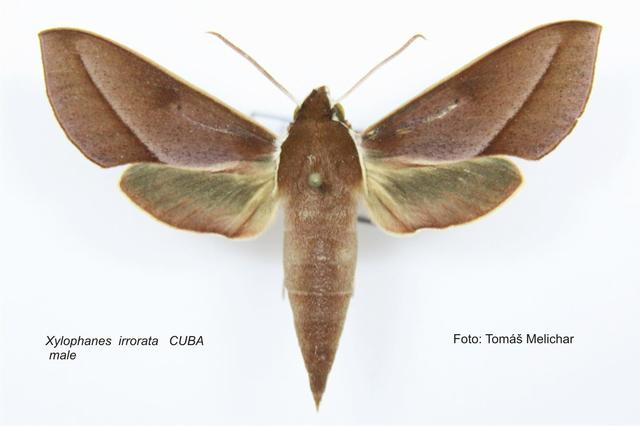Xylophanes irrorata
XYLOPHANES IRRORATA

Xylophanes irrorata male, Cuba, courtesy of Tomas Melichar.
This site has been created by Bill Oehlke. Comments, suggestions and/or additional information are welcomed by Bill.
TAXONOMY:
Family: Sphingidae, Latreille, 1802
Subfamily: Macroglossinae, Harris, 1839
Tribe: Macroglossini, Harris, 1839
Genus: Xylophanes Hubner [1819] ...........
Species: irrorata Grote, 1865
|
DISTRIBUTION:
Xylophanes irrorata moths fly in Cuba (specimen type locality).
Darrell Ferriss confirms a presence in Bahamas with the following image.

Xylophanes irrorata, Long Island, Bahamas, courtesy of Darrell Ferriss
The image directly above shows a moths with a distinct reddish tint. I noticed in one of the photos that Darrell sent me, that the red from the moth seemed
to be transposed slightly by the camera onto the surrounding background. Below is an image from Cuba where the background is reddish. The camera seems to adjust
somewhat in what it picks up. I suspect the brownish moth from Cuba is a little more reddish than displayed, and the reddish moth from Bahamas is a little more
brownish. However, it could just be normal variation within the species, or there could be a subspecies designation warranted.

Xylophanes irrorata, Gran Piedra, Cuba,
June 26, 2016, copyright, Douglas Fernandez, as per
http://www.butterfliesofcuba.com/bombicoidea.html.
FLIGHT TIMES:
Xylophanes irrorata adults probably brood continuously. There is a June flight in Cuba, but there are probably
many other flight months.

Xylophanes irrorata by John Vriesi.
ECLOSION:
Pupae probably wiggle to surface from subterranean chambers just prior to eclosion.

Xylophanes irrorata male, Cuba, courtesy of Tomas Melichar.
SCENTING AND MATING:Females call in the males with a pheromone released from a gland at the tip of the
abdomen. Males come in to lights very readily, but females are seldom taken in that way.
EGGS, LARVAE, PUPAE:
Larvae probably feed on Psychotria panamensis and
Psychotria nervosa and other members of the
of the Rubiaceae family and on
Pavonia guanacastensis of the Malvaceae family.
Moths emerge approximately one-two months after larvae pupate.
Use your browser "Back" button to return to the previous page.
Goto Main Sphingidae Index
Goto Macroglossini Tribe
Goto Central American Indices
Goto Carribean Islands
Goto South American Indices
Goto U.S.A. tables





